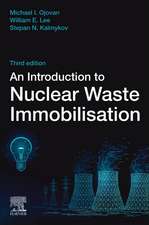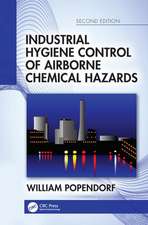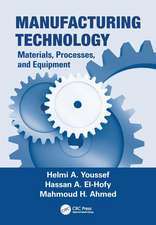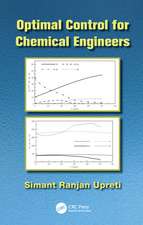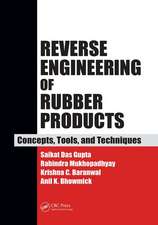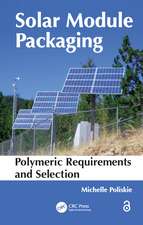Richerson, D: Modern Ceramic Engineering
en Hardback – 9 mai 2018
Preț: 950.30 lei
Preț vechi: 1044.29 lei
-9% Nou
Puncte Express: 1425
Preț estimativ în valută:
181.85€ • 190.10$ • 153.67£
181.85€ • 190.10$ • 153.67£
Carte disponibilă
Livrare economică 13-27 februarie
Livrare express 30 ianuarie-05 februarie pentru 86.54 lei
Preluare comenzi: 021 569.72.76
Specificații
ISBN-13: 9781498716918
ISBN-10: 1498716911
Pagini: 812
Ilustrații: 144 Tables, black and white; 12 Illustrations, color; 560 Illustrations, black and white
Dimensiuni: 186 x 259 x 53 mm
Greutate: 0 kg
Ediția:4 ed
Editura: Taylor & Francis
ISBN-10: 1498716911
Pagini: 812
Ilustrații: 144 Tables, black and white; 12 Illustrations, color; 560 Illustrations, black and white
Dimensiuni: 186 x 259 x 53 mm
Greutate: 0 kg
Ediția:4 ed
Editura: Taylor & Francis
Notă biografică
David W. Richerson received degrees in Ceramic Science and Engineering from the University of Utah (1967) and The Pennsylvania State University (1969). He conducted research on boron carbide armor, silicon nitride, and composites at Norton Company from 1969 to 1973; coordinated materials efforts from 1973 to 1985 at Garrett Turbine Engine Company to integrate ceramic materials into gas turbine engines; and conducted and managed a wide range of materials programs while Director of Research and Development and later Vice President at Ceramatec, Inc. from 1985 to 1991. From 1991 to the present Mr. Richerson has worked as a consultant, taught at the University of Utah, and planned and conducted volunteer science outreach projects in schools and in the community. Mr. Richerson has authored or co-authored 9 books, 13 book chapters, 21 government program final reports, 5 patents, and 59 technical publications and has made numerous technical and educational presentations including two-day to four-day short courses worldwide. Mr. Richerson is a Fellow and past board member of the American Ceramic Society, a member of the National Institute of Ceramic Engineers and the Ceramic Education Council, and a past member of ASM International.
William E. Lee received a BSc in Physical Metallurgy from Aston University in the UK (1980) and a DPhil from Oxford University (1983) on radiation damage in sapphire. After post-doctoral research at Case Western Reserve University he became an Assistant Professor at the Ohio State University USA before returning to a lectureship at Sheffield University in the UK in 1989 and becoming Professor there in 1998. He moved to be head of the Materials Department at Imperial College London in 2006. His research has covered structure-property-processing relations in a range of ceramics including electroceramics, glasses and glass ceramics, nuclear ceramics, refractories, Ultra-high Temperature Ceramics and whitewares. He has supervised 61 students to completion of their PhDs, and authored and co-authored over 400 articles including 5 books, 7 edited proceedings or journal special issues, 6 invited book/encyclopaedia chapters and 14 invited review papers. Prof. Lee is a Fellow of the UKs Royal Academy of Engineering, the City and Guilds Institute, the Institute of Materials, Minerals and Mining and the American Ceramic Society for whom he was President in 2016/17.
William E. Lee received a BSc in Physical Metallurgy from Aston University in the UK (1980) and a DPhil from Oxford University (1983) on radiation damage in sapphire. After post-doctoral research at Case Western Reserve University he became an Assistant Professor at the Ohio State University USA before returning to a lectureship at Sheffield University in the UK in 1989 and becoming Professor there in 1998. He moved to be head of the Materials Department at Imperial College London in 2006. His research has covered structure-property-processing relations in a range of ceramics including electroceramics, glasses and glass ceramics, nuclear ceramics, refractories, Ultra-high Temperature Ceramics and whitewares. He has supervised 61 students to completion of their PhDs, and authored and co-authored over 400 articles including 5 books, 7 edited proceedings or journal special issues, 6 invited book/encyclopaedia chapters and 14 invited review papers. Prof. Lee is a Fellow of the UKs Royal Academy of Engineering, the City and Guilds Institute, the Institute of Materials, Minerals and Mining and the American Ceramic Society for whom he was President in 2016/17.
Cuprins
Part I: Ceramics as Engineering Materials. Part II: Structure and Properties. Part III: Processing of Ceramics. Part IV: Design with Ceramics. Part V: Applying Ceramics to Real World Challenges

